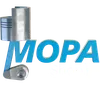STOP damping elements for diesel and marine engines
Damping elements are specialized components that control vibration, shock, and structure-borne noise in engines and their installations. Whether mounted between a power unit and its base frame, integrated in couplings, or used as buffer and suspension elements, they decouple dynamic forces and protect surrounding assemblies. In marine engine rooms, power plants, and industrial facilities, the right selection and condition of damping elements is fundamental to stable operation, compliance with noise limits, and the longevity of machinery.
Within diesel and gas engines, numerous sources generate cyclical forces: combustion pressure, rotating masses, and drivetrain torsion. Damping elements convert a portion of this vibratory energy into heat and isolate it from foundations, piping, and sensitive instrumentation. As a result, they help STOP marine engine resonance from propagating through the hull, improve crew comfort, and safeguard critical components against premature wear.
Technical function: how damping elements STOP vibration in a diesel engine
Damping elements fulfill two core roles: isolation and dissipation. Isolation reduces transmissibility by matching stiffness and mass so that the assembly’s natural frequency remains well below excitation frequencies. Dissipation adds damping to reduce amplitudes near resonant peaks. In a diesel engine, elastomer-metal mounts support the block while accommodating axial, radial, and torque loads. Their dynamic stiffness (not just static hardness) is tuned to the machine’s operating speed range to STOP diesel engine structure-borne noise at the source.
Torsional vibration elements—such as rubber-in-shear or viscous dampers—address crankshaft twist, smoothing torque delivery to couplings and gearboxes. Flexible coupling elements and exhaust hangers add further decoupling to protect shafts, gear trains, pipework, and heat exchangers. Properly engineered damping elements keep the system’s natural frequencies away from dominant excitation orders, minimizing resonance amplification. In practice, engineers select materials (NBR, EPDM, silicone, or high-performance elastomers), define Shore A hardness, and verify dynamic modulus, temperature range, and oil resistance. Metal parts (zinc-nickel or stainless) resist corrosion in marine atmospheres.
For marine applications, classification rules often require vibration criteria on deck and accommodation areas. Tuned damping elements help meet those criteria while preventing fatigue cracks at welds, brackets, and sensor mounts. They also stabilize alignment between the engine, gearbox, and shaft line by controlling displacement under load, which helps STOP marine engine misalignment and extends seal and bearing life.
- · Isolates engine vibration from foundations and structures.
- · Reduces noise and resonance peaks across operating speeds.
- · Protects bearings, couplings, and pipework from shock loads.
- · Tunable stiffness and damping for specific diesel and gas engines.
- · Resistant to oil, fuel mist, salt air, and elevated temperatures.
- · Supports axial, radial, and torque loads with controlled deflection.
- · Enhances alignment stability and component service life.
- · Available as mounts, buffers, bushings, coupling elements, and hangers.
Why damping elements are critical for reliable engine operation
Engine reliability depends on keeping vibration within design limits. Aged or incorrect damping elements can introduce multiple risks: hardened elastomers increase dynamic stiffness, pushing natural frequencies into the operating range; cracked mounts reduce load-carrying capacity; oil-swelled components alter geometry; and corroded inserts compromise integrity. The result can be excessive movement, shaft misalignment, coupling wear, cracked brackets, fatigued exhaust bellows, and damaged sensors or cables.
In marine service, uncontrolled vibration travels along the hull, raising noise levels, accelerating fatigue in supports, and causing nuisance alarms. In power generation, vibration increases losses, undermines generator alignment, and shortens bearing life. Across all sectors, poor damping elevates fuel consumption indirectly by forcing operators to avoid the most efficient load/speed combinations due to resonance. Keeping damping elements in correct specification and condition helps STOP unplanned events, preserves energy efficiency, and maintains safety margins.
Advantages of OEM spare parts suitable for damping elements
Precision and repeatability are decisive in vibration control. OEM spare parts suitable for damping elements provide consistent elastomer compounds, exact hardness tolerances, and validated dynamic stiffness across temperature ranges. Dimensional accuracy ensures that mount heights, preload, and installation geometry match the engine’s design data. This fidelity maintains the tuned natural frequency that the engine builder intended, which is essential to STOP resonance in the operating band.
Material traceability and process control deliver stable properties over time, so replacement elements behave like the initially installed components. Fatigue-tested designs extend service intervals and lower lifecycle cost by reducing secondary damage to couplings, bearings, and piping. Corrosion-resistant metal components and high-quality bonding between rubber and metal withstand marine atmospheres and oil contamination. In short, selecting the right parts helps STOP downtime with OEM parts, supports budget targets through predictable maintenance, and safeguards performance across the service life.
STOP efficiency losses with correctly specified OEM parts
When spare parts match approved specifications, technicians can restore the original vibration profile without reengineering. This reduces commissioning time after overhaul, stabilizes alignment, and secures compliance with vibration and noise criteria—key for ship operators and power producers alike.
MOPA: fast, secure supply of OEM spare parts for damping elements
MOPA is an experienced, reliable partner for OEM spare parts suitable for damping elements in diesel and gas engines. The team supports purchasers and technical decision-makers with rapid sourcing, cross-referencing, and selection assistance for mounts, buffers, torsional elements, and flexible coupling components. Emphasis is placed on speed, quality, and security in every transaction—covering documentation, batch traceability, and logistics tailored to dockings or planned shutdowns.
With a global supplier network and deep engine expertise, MOPA helps STOP delays by delivering the right parts on time, whether for a main marine engine, an auxiliary genset, or stationary CHP units. From technical clarification to delivery, the process is designed to reduce risk and keep assets running at optimal vibration levels.
Conclusion
Damping elements are indispensable for controlling vibration, protecting components, and ensuring the efficient, safe operation of diesel and marine engines. Specified and maintained correctly, they STOP resonance, reduce noise, and extend equipment life.
Choosing OEM spare parts suitable for damping elements preserves tuned performance, minimizes downtime, and supports long-term budget targets. With MOPA as a partner, operators gain fast, reliable access to the parts and expertise needed to keep vibration under control.





